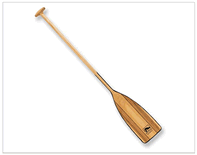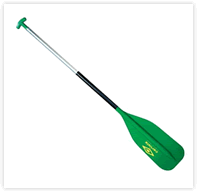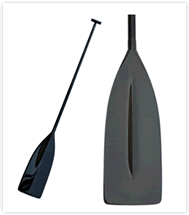Choosing a canoe paddle might not seem like a big deal because one paddle propels the canoe as well as the other, right? Actually that statement isn’t accurate as there are distinct differences in canoe paddle designs and they all affect the efficiency of your paddling in one way or another.
The Very Basics of Canoe Paddle Materials
To better understand the differences in canoe paddles we should start by taking a look at the materials used to construct the paddles, and while in most cases there is no real right or wrong material, the material and style you choose will make a noticeable difference in your paddling.
 Wood canoe paddles are popular for many reasons and appearance is one of those reasons. Wood paddles are also more comfortable and natural in your hands, and some paddlers suggest that because of the sensitivity of wood paddles you get a better feeling of how the paddle reacts with the water as you stroke, but they do require some occasional maintenance as the wood paddle will become cracked and damaged with time. Depending on the manufacturer and quality of paddle you select, a decent wood paddle can be begin in the $65 price range and increase to several hundred dollars. But it’s generally a good idea to spend a little extra on a quality wooden paddle rather than purchase cheap. Wooden paddles are ideal for deeper flatwater situations but can be purchased or modified with protective blade ends for paddling shallow rocky water too.
Wood canoe paddles are popular for many reasons and appearance is one of those reasons. Wood paddles are also more comfortable and natural in your hands, and some paddlers suggest that because of the sensitivity of wood paddles you get a better feeling of how the paddle reacts with the water as you stroke, but they do require some occasional maintenance as the wood paddle will become cracked and damaged with time. Depending on the manufacturer and quality of paddle you select, a decent wood paddle can be begin in the $65 price range and increase to several hundred dollars. But it’s generally a good idea to spend a little extra on a quality wooden paddle rather than purchase cheap. Wooden paddles are ideal for deeper flatwater situations but can be purchased or modified with protective blade ends for paddling shallow rocky water too.
 Aluminum canoe paddles are constructed from an aluminum shaft and usually a polyethylene blade. They are popular because they are cheaper, durable and forever lasting, and you can do things with aluminum paddles you wouldn’t normally do with wooden or carbon paddles, such as pushing off rocks and prying your way out of sticky situations. But the downside to these paddles is that they are much heavier than other paddle materials and those extra ounces add up over several hundred paddle strokes. Despite the extra weight I think aluminum paddles are the most practical canoe paddle to own; I own several of them for shallow water paddling and I think every paddler should have a few of them available for shallow rocky water paddling or as an extra paddle.
Aluminum canoe paddles are constructed from an aluminum shaft and usually a polyethylene blade. They are popular because they are cheaper, durable and forever lasting, and you can do things with aluminum paddles you wouldn’t normally do with wooden or carbon paddles, such as pushing off rocks and prying your way out of sticky situations. But the downside to these paddles is that they are much heavier than other paddle materials and those extra ounces add up over several hundred paddle strokes. Despite the extra weight I think aluminum paddles are the most practical canoe paddle to own; I own several of them for shallow water paddling and I think every paddler should have a few of them available for shallow rocky water paddling or as an extra paddle.
 Fiberglass and carbon fiber canoe paddles are lightweight and strong, making them extremely versatile and a pleasure to use, but they tend to be the most expensive of all the paddle materials starting at around $150. These paddles are high performance paddles usually used by experienced canoeists. I don’t recommend inexperienced canoeists run out and make a purchase on a fiberglass or carbon paddle immediately as your money can be better spent elsewhere. While they are tough they aren’t as tough as the wood or aluminum/polyethylene paddles.
Fiberglass and carbon fiber canoe paddles are lightweight and strong, making them extremely versatile and a pleasure to use, but they tend to be the most expensive of all the paddle materials starting at around $150. These paddles are high performance paddles usually used by experienced canoeists. I don’t recommend inexperienced canoeists run out and make a purchase on a fiberglass or carbon paddle immediately as your money can be better spent elsewhere. While they are tough they aren’t as tough as the wood or aluminum/polyethylene paddles.
So my recommendations for a beginner’s canoe paddle are to make your selection based on the type of paddling you will be doing. If you are paddling deeper flatwater opt for a good quality wooden paddle and pick up an aluminum/polyethylene paddle as a spare or shallow water paddle. If you are paddling mainly shallow rivers and creeks the aluminum/polyethylene paddles are an excellent paddle to get started with, then you can graduate to something more expensive and specialized down the road. And if you are racing canoes or just have money burning a hole in your pocket then shop for the fiberglass or carbon fiber paddle.
Soon I’ll discuss canoe paddles in details such as the bent shaft paddle, the whitewater paddle, and how to fit your paddle to you.

